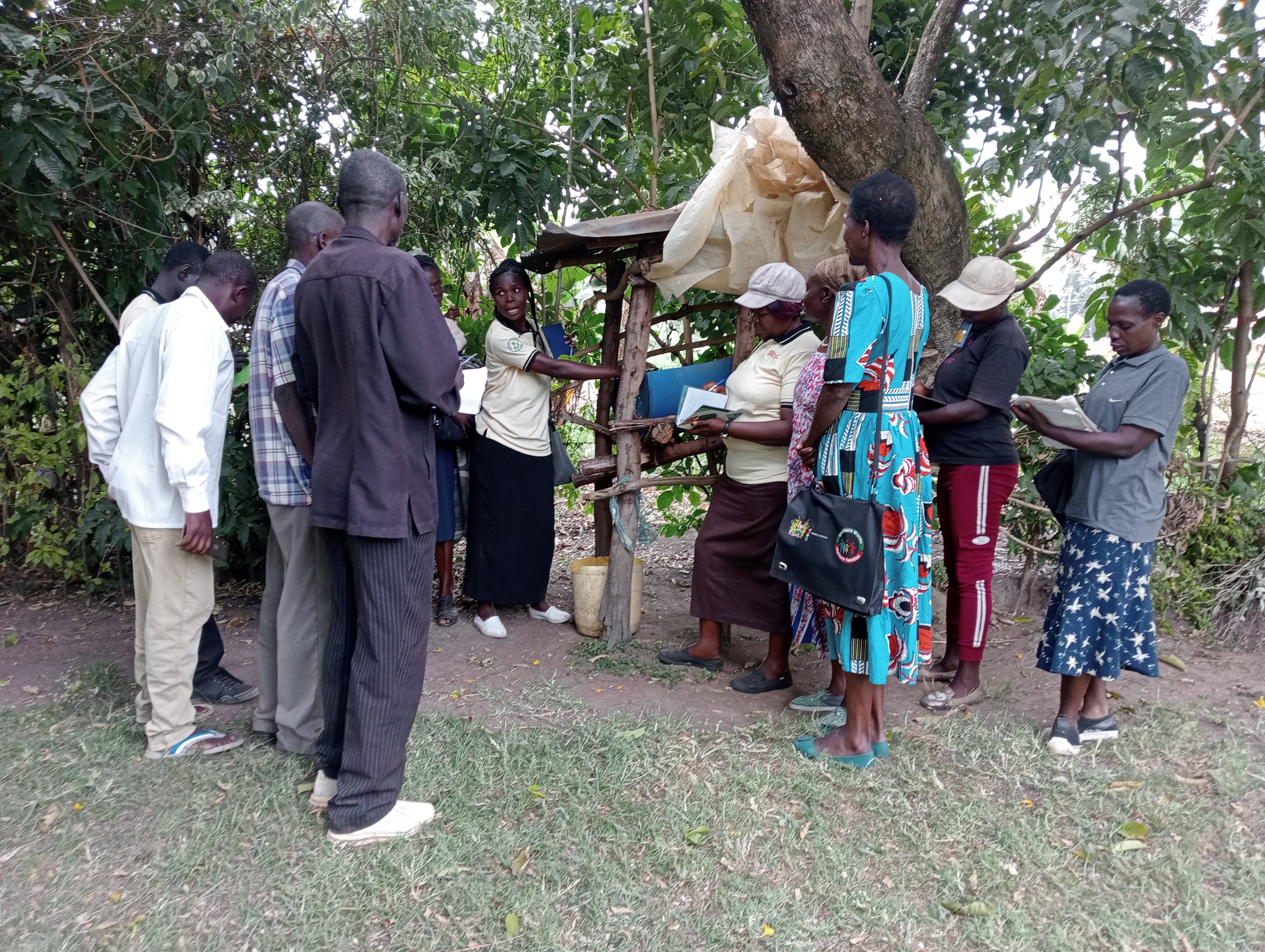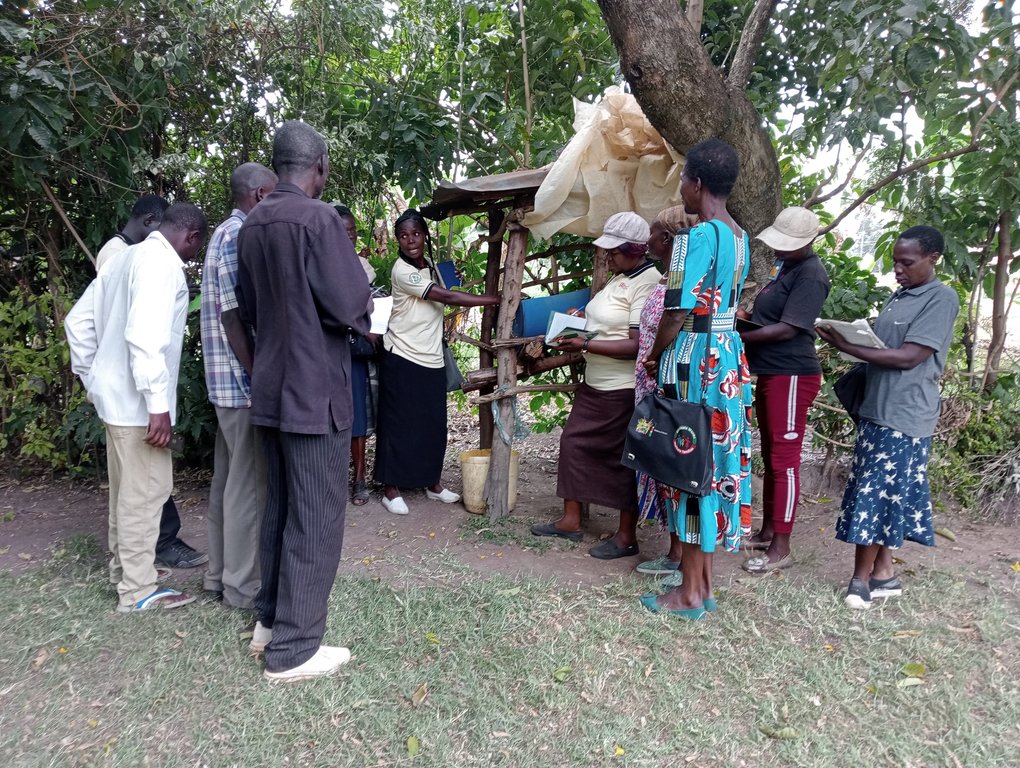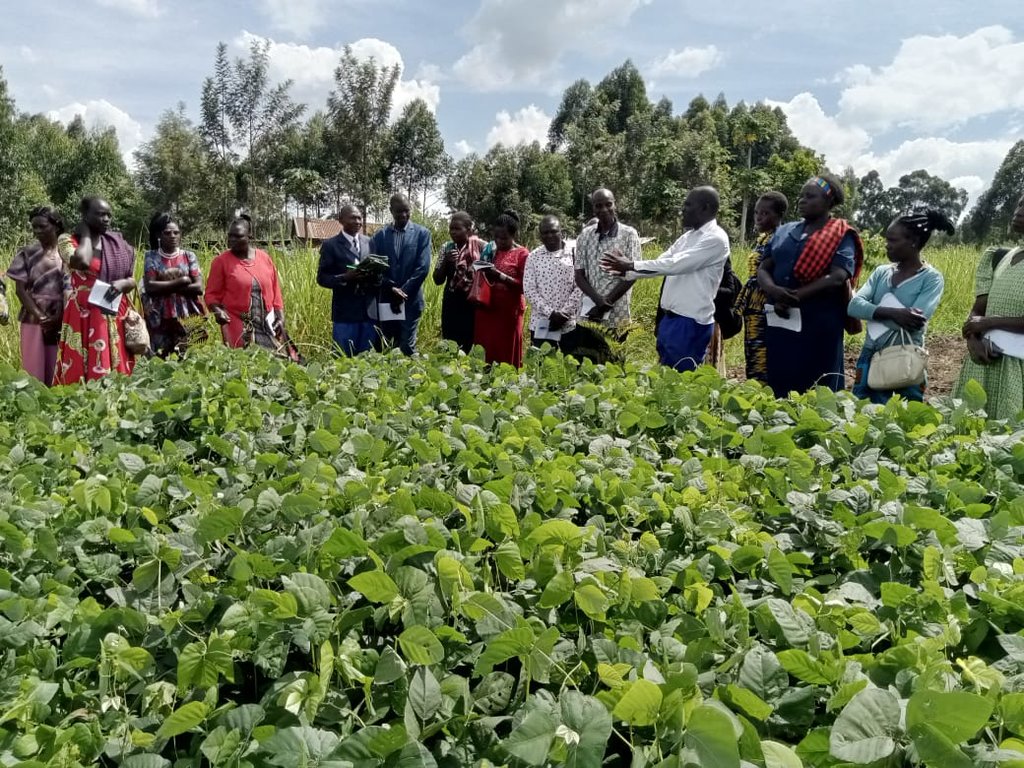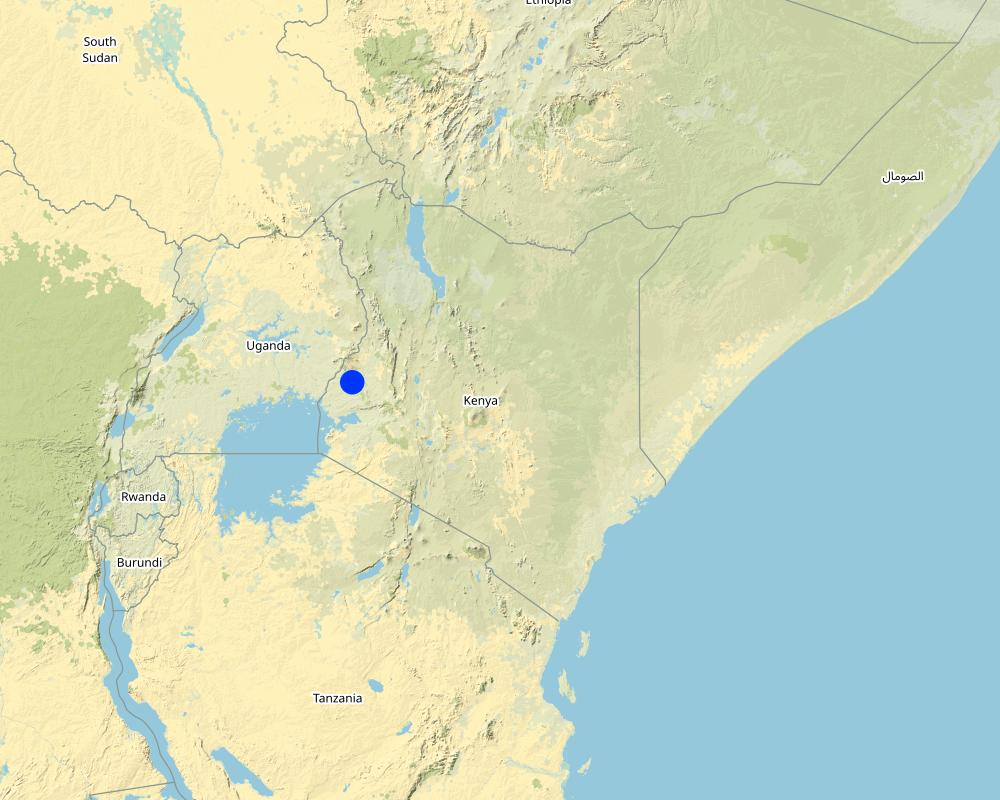Community Resource Persons (CRP) in agricultural extension [Kenya]
- Creation:
- Update:
- Compiler: William Akwanyi
- Editors: Maureen Elegwa, Innocent Faith, Noel Templer
- Reviewers: William Critchley, Rima Mekdaschi Studer
Mtu wa rasilimali za jamii/ Mkufunzi wa wakufunzi
approaches_6688 - Kenya
View sections
Expand all Collapse all1. General information
1.2 Contact details of resource persons and institutions involved in the assessment and documentation of the Approach
Key resource person(s)
SLM specialist:
Nyanja Churchill
+254 710 849370
churchillwn2@gmail.com
Kimaeti Farmers Community-Based Organization (CBO)
Bukembe East Ward, Kanduyi Sub-county, Bungoma County
Kenya
SLM specialist:
SLM specialist:
Name of project which facilitated the documentation/ evaluation of the Approach (if relevant)
Soil protection and rehabilitation for food security (ProSo(i)l)Name of the institution(s) which facilitated the documentation/ evaluation of the Approach (if relevant)
Deutsche Gesellschaft für Internationale Zusammenarbeit (GIZ)Name of the institution(s) which facilitated the documentation/ evaluation of the Approach (if relevant)
Alliance Bioversity and International Center for Tropical Agriculture (Alliance Bioversity-CIAT) - Kenya1.3 Conditions regarding the use of data documented through WOCAT
When were the data compiled (in the field)?
03/02/2023
The compiler and key resource person(s) accept the conditions regarding the use of data documented through WOCAT:
Yes
1.4 Reference(s) to Questionnaire(s) on SLM Technologies
2. Description of the SLM Approach
2.1 Short description of the Approach
Community Resource Persons (CRP) form a farmer-to-farmer learning approach that bridges the gap in agricultural extension, increases farmers' access to agricultural information (SLM knowledge), and increases the adoption of SLM practices.
2.2 Detailed description of the Approach
Detailed description of the Approach:
Community Resource Persons (CRPs) are farmers at the community-level who promote the adoption of SLM technologies by offering agricultural extension services. GIZ implements the ProSoil project in the Western Kenya counties of Kakamega, Siaya, and Bungoma through partners i.e., Welthungerhilfe (WHH) and Gesellschaft für Agrarprojekte in Übersee (GFA Consulting Group/ GFA). Further, these partners collaborate with other local non-governmental organizations (NGOs) and community-based organizations (CBOs) in the implementation of the project. Farmer groups belonging to local communities characterized by men, women, and youth are recruited by field officers from the implementing partners and trained in Sustainable Land Management (SLM) practices. The training is done by technical staff from the County Department of Agriculture. The implementing partners facilitate the trainings. The trained farmers (CRPs) are issued with certificates of recognition signed by GIZ ProSoil project manager, the head of the implementing partner, and the County Director of Agriculture at the County Department of Agriculture. These CBOs and farmer groups work closely with agricultural extension officers from the county departments of agriculture to disseminate different agricultural technologies and SLM measures. The aim of CRPs is to bridge the gap in agricultural extension by overcoming the problem of low extension staff-to-farmer ratios. The objective is to sustain the adoption of various SLM measures promoted by the project among the beneficiaries and non-project farmers.
In Bukembe East Ward, Bungoma County, GFA collaborates with Kimaeti Farmers CBO to implement the Soil Protection and Rehabilitation of Degraded Soil for Food Security (ProSoil) project. Kimaeti Farmers CBO recruited agriculture field technicians who were then trained in SLM practices by GFA. The trained field technicians sensitize local communities in various operational areas about the project and recruit farmer groups: 25 farmers per group. Each field technician manages several groups per sub location and takes them through trainings and demonstrations on soil protection and rehabilitation technologies. Farmer groups are also trained on group organization development and management to enhance group cohesion. Each farmers group selects 3 CRPs who undergo specialized training to equip them with more skills and expertise to follow up, mentor and coach fellow farmers. These CRPs also monitor implementation of various technologies, gather farmer feedback, and even reach out to other farmers in the community not reached by the project. This extension service is usually done voluntarily. However, some farmers reward the CRPs for the advisory services in cash or kind. In some cases, CRPs who are specialised in some SLM technologies e.g., construction of structures for vermicomposting become co-trainers and may enter into contractual agreements with GIZ, GFA, or any other institution that wants their services. In this case, they are paid as agreed on the contracts.
Each CRP manages a cluster of 5–7 farmers. They also reach out to farmers within their respective communities according to consultatively agreed calendars/timeframes. Every available opportunity is used by CRPs to spread SLM knowledge, including meeting farmers at their farms; convening farmers at common locations within their communities where they talk to them about SLM; farmer field days organised by the implementing partners, or the county department of agriculture, etc. Hence, CRPs attract the attention of many farmers, including those who are direct beneficiaries of the ProSoil project and those who are not direct beneficiaries. CRPs are thus important in improving farmers' access to agricultural information at little or no cost since CRPs work on a voluntary basis.
The CRP approach has been successful in bringing together female and male, and youthful, middle-aged, and elderly farmers of different socio-cultural and economic backgrounds on issues of common interest i.e., SLM, household food security, and economic empowerment. This has enhanced communication, built social solidarity, and enhanced social cohesion among the farmers.
2.3 Photos of the Approach
2.5 Country/ region/ locations where the Approach has been applied
Country:
Kenya
Region/ State/ Province:
Bungoma County in Western Kenya
Further specification of location:
Bukembe East Ward, Kanduyi Sub-county, Bungoma County
Map
×2.6 Dates of initiation and termination of the Approach
Indicate year of initiation:
2021
Comments:
Farmers are still learning from each other through the CRP approach.
2.7 Type of Approach
- project/ programme based
2.8 Main aims/ objectives of the Approach
Aim: To bridge the gap in agricultural extension.
Objectives:
1. To improve farmers' access to agricultural information.
2. To sustain the adoption of new technologies trained to the project beneficiaries and non-project farmers.
3. To overcome the problem of low extension staff-to-farmer ratio through farmer-to-farmer learning.
2.9 Conditions enabling or hindering implementation of the Technology/ Technologies applied under the Approach
social/ cultural/ religious norms and values
- enabling
1. General acceptance by the community.
2. Ability to bring together of different socio-cultural and economic backgrounds on issues of common interest i.e., SLM, household food security, and economic empowerment which has enhanced communication, built social solidarity, and enhanced social cohesion among community members.
availability/ access to financial resources and services
- hindering
CRPs work on voluntary basis; hence, may not be motivated to reach out to farmers in areas that are very far from their reach.
institutional setting
- enabling
Availability and willingness of Kimaeti CBO to collaborate with GFA.
collaboration/ coordination of actors
- enabling
Linkages and partnerships among different organizations and institutions, including GIZ, GFA, Kimaeti CBO, etc. which expanded the outreach of the approach.
legal framework (land tenure, land and water use rights)
- enabling
Access to farming land where farmers implement SLM technologies.
land governance (decision-making, implementation and enforcement)
- hindering
Women and youth farmers are limited in their access, use, and control of land. Hence, they may not be able to implement certain SLM technologies even if they gained knowledge about them through CRPs who are fellow farmers e.g., agroforestry.
knowledge about SLM, access to technical support
- enabling
SLM knowledge among technical staff in the collaborating institutions and documented references.
workload, availability of manpower
- enabling
CRPs from the communities who are willing to work with fellow farmers.
- hindering
Voluntary nature of the CRPs' support - CRPs are likely to sacrifice their own farmwork at the expense of the CRP work, something that may discourage them if they get poor harvest.
3. Participation and roles of stakeholders involved
3.1 Stakeholders involved in the Approach and their roles
- local land users/ local communities
Farmers - men, women, and youth.
Targeted by the technologies, they learn from other farmers, and implement the technologies.
- community-based organizations
Kimaeti Farmers Community-Based Organization
Has recruited a team of trained SLM specialists who pass the SLM knowledge to the community resource persons in the community.
- SLM specialists/ agricultural advisers
SLM specialists from GIZ ProSoil project, GFA, and Kimaeti Farmers Community-Based Organization.
SLM specialists from GIZ ProSoil project - supported in the technical design of the approach.
SLM specialists from GFA - ProSoil implementing partner, trains the Community-Based Organizations that implement the approach.
SLM specialists from Kimaeti Farmers Community-Based Organization - pass the SLM knowledge to the community resource persons in the community.
- local government
Agricultural extension officers from the county government department of agriculture.
Work hand-in-hand with SLM specialists to pass the SLM knowledge to the farmers.
- international organization
GIZ
Proposal design and financial support to the implementation of the approach.
If several stakeholders were involved, indicate lead agency:
GIZ
3.2 Involvement of local land users/ local communities in the different phases of the Approach
| Involvement of local land users/ local communities | Specify who was involved and describe activities | |
|---|---|---|
| initiation/ motivation | passive | Farmers in the community, targeted by the SLM technologies, they implement the technologies. |
| planning | interactive | Community resource persons and other farmers in the community jointly agree on when to engage each other, especially time and venue for capacity building. |
| implementation | interactive | Based on the status of the farmers, including land size, available capital, status of land degradation, etc. community resource persons and other farmers decide which SLM technologies are best for each farm. |
| monitoring/ evaluation | passive | The planning for and conduct of monitoring and/ or evaluation is a role of GIZ and WHH. Farmers are mainly interviewed based on pre-determined questions. |
| Research | none |
3.3 Flow chart (if available)
Description:
The ProSoil Project (GIZ and GFA) provides financial resources for the training of CRPs. The CRPs are trained by SLM specialists from the County Department of Agriculture. The CRPs provide advisory services to farmers.
Author:
William Akwanyi
3.4 Decision-making on the selection of SLM Technology/ Technologies
Specify who decided on the selection of the Technology/ Technologies to be implemented:
- mainly land users, supported by SLM specialists
Explain:
Decisions on what SLM technologies to implement were made mainly by farmers supported by SLM specialists from GIZ ProSoil project, GFA, and Kimaeti Farmers Community-Based Organization.
Specify on what basis decisions were made:
- evaluation of well-documented SLM knowledge (evidence-based decision-making)
- personal experience and opinions (undocumented)
4. Technical support, capacity building, and knowledge management
4.1 Capacity building/ training
Was training provided to land users/ other stakeholders?
Yes
Specify who was trained:
- land users
- field staff/ advisers
If relevant, specify gender, age, status, ethnicity, etc.
CRPs from each village of about 25 farmers
Form of training:
- on-the-job
- farmer-to-farmer
- demonstration areas
Subjects covered:
1. Conservation Agriculture
2. Agroforestry
3. Soil and Water Conservation measures
4. Integrated Soil Fertility and Pest Management (ISF&PM)
5. Push-pull
6. Good Agronomic Practices
Comments:
GFA trained/ trains Kimaeti Farmers CBO field technicians in SLM. The trained technicians then train the CRPs.
4.2 Advisory service
Do land users have access to an advisory service?
Yes
Specify whether advisory service is provided:
- on land users' fields
- at permanent centres
Describe/ comments:
CRPs advise farmers at their farms whenever they visit them. Meetings are held on needs basis between farmers and the CRPs where pieces of advice are given to farmers.
4.3 Institution strengthening (organizational development)
Have institutions been established or strengthened through the Approach?
- yes, greatly
Specify the level(s) at which institutions have been strengthened or established:
- local
Describe institution, roles and responsibilities, members, etc.
Kimaeti Farmers CBOs and farmer groups at community level whose member farmers are capacity build and are able to learn from each other.
Specify type of support:
- capacity building/ training
Give further details:
Kimaeti Farmers CBO technical officers have been trained in SLM practices.
4.4 Monitoring and evaluation
Is monitoring and evaluation part of the Approach?
Yes
Comments:
GIZ and GFA regularly follows up with farmers to check on the implementation of technologies promoted under this approach.
If yes, is this documentation intended to be used for monitoring and evaluation?
No
Comments:
This documentation in intended for keeping a record of SLM technologies and approaches.
4.5 Research
Was research part of the Approach?
No
5. Financing and external material support
5.1 Annual budget for the SLM component of the Approach
If precise annual budget is not known, indicate range:
- 10,000-100,000
Comments (e.g. main sources of funding/ major donors):
Training costs for training 25 CRPs met by GIZ through GFA.
5.2 Financial/ material support provided to land users
Did land users receive financial/ material support for implementing the Technology/ Technologies?
No
5.3 Subsidies for specific inputs (including labour)
- none
Comments:
No labour was provided by land users.
5.4 Credit
Was credit provided under the Approach for SLM activities?
No
5.5 Other incentives or instruments
Were other incentives or instruments used to promote implementation of SLM Technologies?
Yes
If yes, specify:
Value addition to promote marketability of farm produce e.g., mucuna. This encouraged farmers to grow mucuna as a green manure cover crop.
6. Impact analysis and concluding statements
6.1 Impacts of the Approach
Did the Approach enable evidence-based decision-making?
- No
- Yes, little
- Yes, moderately
- Yes, greatly
Farmers were motivated to implement the SLM technologies that they were trained on by the CRPs, especially having seen how the CRPs had benefited from the SLM practices.
Did the Approach help land users to implement and maintain SLM Technologies?
- No
- Yes, little
- Yes, moderately
- Yes, greatly
The CRPs reached out to the land users/ farmers and taught them how to implement the SLM technologies.
Did the Approach improve coordination and cost-effective implementation of SLM?
- No
- Yes, little
- Yes, moderately
- Yes, greatly
Farmers are not paying for the extension services that they receive from the CRPs.
Did the Approach mobilize/ improve access to financial resources for SLM implementation?
- No
- Yes, little
- Yes, moderately
- Yes, greatly
Did the Approach improve knowledge and capacities of land users to implement SLM?
- No
- Yes, little
- Yes, moderately
- Yes, greatly
SLM knowledge received from the CRPs.
Did the Approach build/ strengthen institutions, collaboration between stakeholders?
- No
- Yes, little
- Yes, moderately
- Yes, greatly
Collaboration of GFA and GIZ, GFA and Kimaeti Farmers CBO strengthened.
Did the Approach empower socially and economically disadvantaged groups?
- No
- Yes, little
- Yes, moderately
- Yes, greatly
Farmers with limited resources to invest in capacity building/ training received free SLM knowledge.
6.2 Main motivation of land users to implement SLM
- increased production
Farmers harvested more after implementing the SLM technologies than when they were not implementing the technologies.
- reduced land degradation
Most promoted SLM practices reduced degradation of farmlands e.g., soil and water conservation measures.
- prestige, social pressure/ social cohesion
Farmers of diverse social and economic statuses could meet for a common goal of learning about SLM.
- enhanced SLM knowledge and skills
Farmers received training about SLM from the CRPs.
- conflict mitigation
CRPs are able to solve conflicts that arise within the groups
6.3 Sustainability of Approach activities
Can the land users sustain what has been implemented through the Approach (without external support)?
- yes
If yes, describe how:
Most of the SLM practices promoted under the approach have greatly improved the farms. Hence, a motivation to continue implementing even without donor support.
6.4 Strengths/ advantages of the Approach
| Strengths/ advantages/ opportunities in the land user’s view |
|---|
| Easy access to CRPs since they are members of the same communities with the target farmers. |
| Evidence-based learning from fellow farmers is a motivation for farmers to invest in SLM. |
| It could be a source of income for the CRPs; some earn an income by providing extension services to other farmers |
| Strengths/ advantages/ opportunities in the compiler’s or other key resource person’s view |
|---|
| A cost-effective method of disseminating agricultural information. |
6.5 Weaknesses/ disadvantages of the Approach and ways of overcoming them
| Weaknesses/ disadvantages/ risks in the land user’s view | How can they be overcome? |
|---|---|
| CRPs may lack resources to reach out to farmers since they work on voluntary basis. | Formal recognition of CRPs by the government of Kenya. Government setting aside some funds to support the CRPs |
| Resistance from some farmers. | CRPs to be provided with some form of identification, |
7. References and links
7.1 Methods/ sources of information
- field visits, field surveys
One field visit involving demonstration of how CRPs interact with farmers.
- interviews with land users
Discussion with a CRP group
- interviews with SLM specialists/ experts
Interview with GFA and Kimaeti CBO SLM specialist and several follow-up calls.
7.3 Links to relevant information which is available online
Title/ description:
Training Community Resource Persons and Panchayat members in Tamil Nadu
URL:
https://indo-germanbiodiversity.com/project-details-265.html
Links and modules
Expand all Collapse allLinks
No links
Modules
No modules






